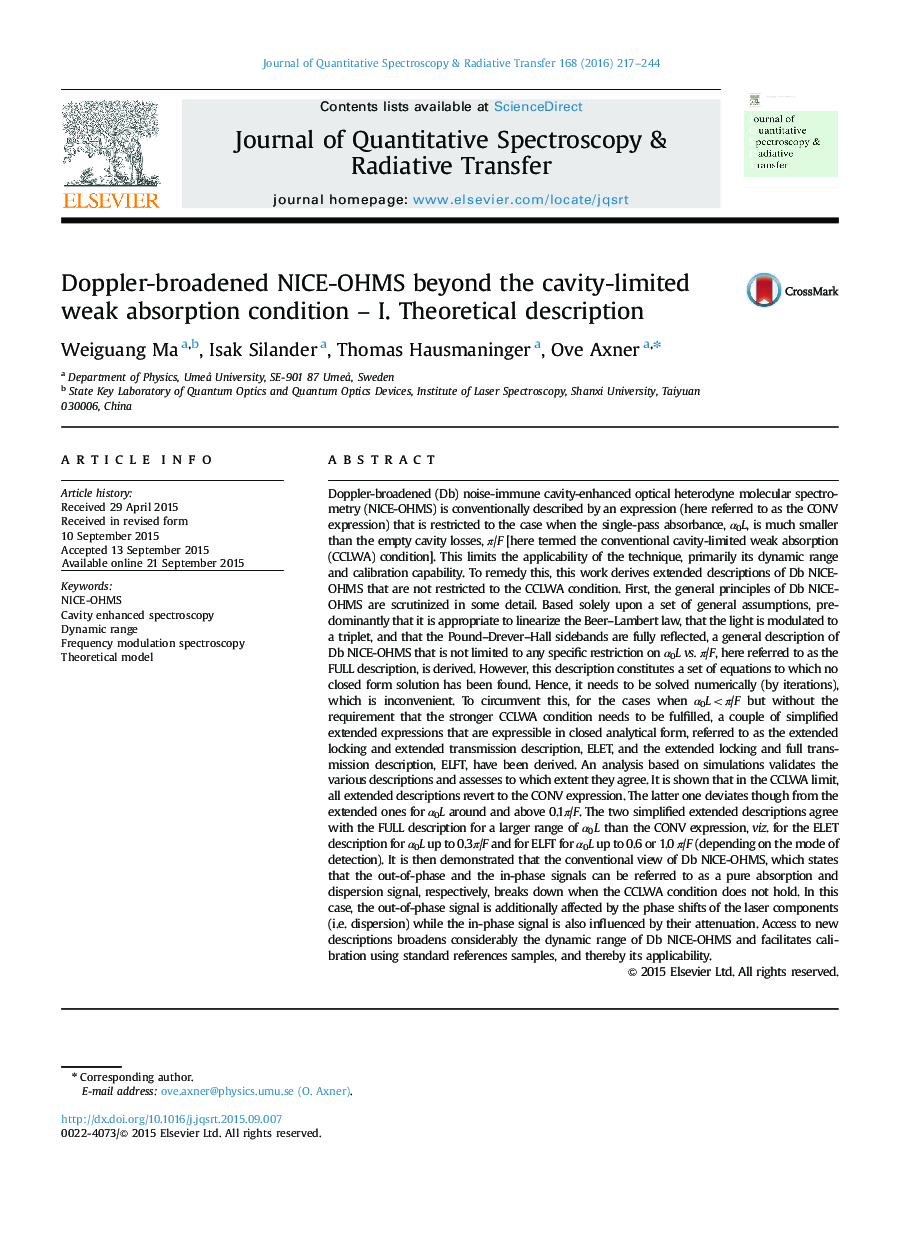| کد مقاله | کد نشریه | سال انتشار | مقاله انگلیسی | نسخه تمام متن |
|---|---|---|---|---|
| 5427798 | 1508647 | 2016 | 28 صفحه PDF | دانلود رایگان |

- The principles of Doppler-broadened (Db) NICE-OHMS are carefully scrutinized.
- Several theoretical descriptions of Db NICE-OHMS are derived.
- These are valid for single-pass absorbance up to the empty cavity losses.
- The new descriptions broadens the dynamic range of Db NICE-OHMS.
- It also facilitates calibration using standard references samples.
Doppler-broadened (Db) noise-immune cavity-enhanced optical heterodyne molecular spectrometry (NICE-OHMS) is conventionally described by an expression (here referred to as the CONV expression) that is restricted to the case when the single-pass absorbance, α0L, is much smaller than the empty cavity losses, Ï/F [here termed the conventional cavity-limited weak absorption (CCLWA) condition]. This limits the applicability of the technique, primarily its dynamic range and calibration capability. To remedy this, this work derives extended descriptions of Db NICE-OHMS that are not restricted to the CCLWA condition. First, the general principles of Db NICE-OHMS are scrutinized in some detail. Based solely upon a set of general assumptions, predominantly that it is appropriate to linearize the Beer-Lambert law, that the light is modulated to a triplet, and that the Pound-Drever-Hall sidebands are fully reflected, a general description of Db NICE-OHMS that is not limited to any specific restriction on α0L vs. Ï/F, here referred to as the FULL description, is derived. However, this description constitutes a set of equations to which no closed form solution has been found. Hence, it needs to be solved numerically (by iterations), which is inconvenient. To circumvent this, for the cases when α0L<Ï/F but without the requirement that the stronger CCLWA condition needs to be fulfilled, a couple of simplified extended expressions that are expressible in closed analytical form, referred to as the extended locking and extended transmission description, ELET, and the extended locking and full transmission description, ELFT, have been derived. An analysis based on simulations validates the various descriptions and assesses to which extent they agree. It is shown that in the CCLWA limit, all extended descriptions revert to the CONV expression. The latter one deviates though from the extended ones for α0L around and above 0.1Ï/F. The two simplified extended descriptions agree with the FULL description for a larger range of α0L than the CONV expression, viz. for the ELET description for α0L up to 0.3Ï/F and for ELFT for α0L up to 0.6 or 1.0 Ï/F (depending on the mode of detection). It is then demonstrated that the conventional view of Db NICE-OHMS, which states that the out-of-phase and the in-phase signals can be referred to as a pure absorption and dispersion signal, respectively, breaks down when the CCLWA condition does not hold. In this case, the out-of-phase signal is additionally affected by the phase shifts of the laser components (i.e. dispersion) while the in-phase signal is also influenced by their attenuation. Access to new descriptions broadens considerably the dynamic range of Db NICE-OHMS and facilitates calibration using standard references samples, and thereby its applicability.
Journal: Journal of Quantitative Spectroscopy and Radiative Transfer - Volume 168, January 2016, Pages 217-244